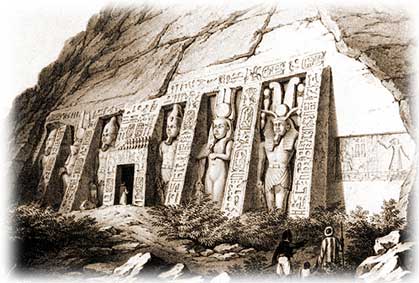 |
|
 |
|
MY DEAREST PEOPLE,
Here we are arrived at the last and greatest point of our voyage -greatest it is in all respects-I can fancy nothing greater. All that I have imagined has fallen short of Ipsamboul (of the great temple of the Osirides), and thank God that we have come here. I can conceive nothing in Thebes to equal this, and am well satisfied to turn back now, for we are to go no further. We arrived here on the 15th, about nine o'clock, and climbed the bank immediately to the lesser temple to see that first. There is no effect about the exterior at all, you don't know where the rock ends, and the temple begins, the slanting lines of the face of the temple (none of them parallel) are ugly, and the six colossal figures between the slants impossible to see, as the bank slopes straight down from the temple door to the river. Yet I have a love for the place; it is so innocent, so childish, so simple, so like the Athor, "the Lady of Aboccis" (the old name of Aboo Simbil) whom it represents. Athor means the habitation of Horus, and Horus means God; therefore Athor is nature, the world, in which God dwells, and which reveals Him. Her inscription calls her the "nurse, who fills heaven and earth with her beneficent acts". As such, she is identical with Isis. And her temple is so like nature, cheerful and simple, and to me at least, not very interesting, with her great broad innocent face and child-like expression, for it would not do if nature always kept us in a state of excitement. She is the same as the Grecian Aphrodite, yet how different her simple, almost infantine, beauty to the more intellectual, yet at the same time more sensual, conscious beauty of the Greek Venus. It is the difference between Aspasia and Desdemona. She is also the goddess of joy, the lady of the dance and mirth, a sort of joy like that of children playing at daisy chains, not that of the feast of Epicurus. She is a secondary goddess, and her connection with the earth is mo.re intimate than that of the real goddesses-her expression shows none of their supernatural serenity, but a simple enjoyment of her flowers and creatures.

The temple is small, the first chamber hewn in the rock and supported by six pillars, with the Athor head upon each; then a vestibule or pro sekos; then the sekos or sacred place, with her image in it. It was built by the Great Rameses, of the nineteenth dynasty, who reigned thirteen centunes and a half before Christ. The conqueror and Sesostris of the Greeks, and his figure, with those of his two queens, both evidently portraits, and one a most beautiful woman, are in "intaglio nlevato", all over the walls. Everywhere Rameses' queens occupy as conspicuous a place as himself. One only of the representations interested me much. It was the Great Rameses crowned by the good and the evil principle on either side. What a deep philosophy!-what theory of the world has ever gone farther than this? The evil is not the opposer of the good, but its collaborateur-the left hand of God, as the good is His right. I don't think I ever saw anything which affected me much more than this (3000 years ago)-the king at his entrance into life is initiated into the belief that what we call the evil was the giver of life and power as well as the good. Tell Aunt M. I thought of her when I looked at him, and of all she had taught me, and rejoiced to think how the same light dawns upon the wise from the two ends of space and of time.
The old Egyptians believed that out of good came forth evil, and out of evil came forth good; or as I should translate it, out of the well ordered comes forth the inharmonious, the passionate; and out of disorder again order; and both are a benefit. The Romans, who were a more literal people, and we their descendants, never understood this, and have set our faces against evil, like the later Egyptians, and scratched his nose.
Some people have seen a portrait of Joseph in the ass-headed god with square ears, Ombte. I myself incline to this opinion, considering him under the later idea; as I never could bear Joseph for making all the free property of Egypt into king's property, the fee simple of all Egypt into leasehold, the cause of half the evil at this present day.
But I am in a hurry to
get on to the great temple, the Temple of the Sun, as he stands
side by side with the modest little temple of his daughter, the
mistress of the West, the lady of evening, of the morning star
(Athor), who receives him every night at the end of his course
behind her mountain, when he sets into her resting-place.
----------
Florence Nightingale, Letters from Egypt, 1849-1850